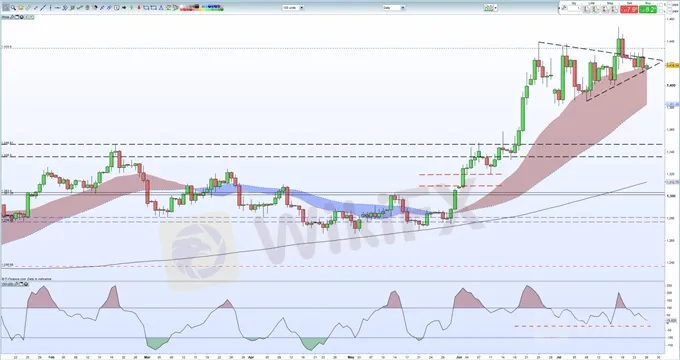简体中文
繁體中文
English
Pусский
日本語
ภาษาไทย
Tiếng Việt
Bahasa Indonesia
Español
हिन्दी
Filippiiniläinen
Français
Deutsch
Português
Türkçe
한국어
العربية
Gold Price Prepares to Breakout as FOMC Rate Decision Nears
Abstract:Gold continues to bide its time before its next move with price action tempered ahead of next weeks FOMC rate decision when the Fed is fully expected to start cutting interest rates.
FOMC Rate Decision and Gold (XAU) Price, Analysis and Chart
Gold remains constrained but a breakout looms.
FOMC will begin cutting interest rates next Wednesday.
Q3 2019 Gold Forecast and Top Trading Opportunities
Gold Stuck in a Technical Pattern Ahead of the Fed
Gold remains in a narrowing triangular pattern and any breakout will likely wait for next Wednesdays FOMC rate decision where the Fed will embark on a series of interest rate cuts to help boost the economy. A 0.25% rate cut is fully priced-in while expectations of a 0.50% have drifted lower recently to around 17%. While the interest rate cut is priced-in, the post-decision Fed language will be parsed closely to see if the central bank gives any clues to the path of future rate cuts. Next Friday also sees the latest US labor report, another important US dollar shifting event.
The DailyFX Calendar covers all important market moving data releases and events.
The daily gold chart shows how the price of gold has been constrained this week in a triangular formation and points to a breakout on the horizon. The precious metal has respected the upper and lower trend lines this week and todays price action is muted with gold trading in a narrow $5/oz. range. All three moving averages remain supportive, while the CCI indicator shows that gold has moved out of overbought territory and is nearing its lowest level in nearly two-months. Gold needs to break and close either below or above trend to define the next move. Support remains at $1,400/oz. while to the upside $1433/oz. ahead of $1,439/oz. and then a fresh re-test of the $1,453/oz. six-year high.
Gold Price Daily Chart (January – July 26, 2019)

IG Client Sentiment data show that 72.3% of retail traders are net-long of gold, a bearish contrarian indicator. However, recent daily and weekly positional changes give us a stronger bearish contrarian bias.
Disclaimer:
The views in this article only represent the author's personal views, and do not constitute investment advice on this platform. This platform does not guarantee the accuracy, completeness and timeliness of the information in the article, and will not be liable for any loss caused by the use of or reliance on the information in the article.
Read more

KVB Market Analysis | 30 August: JPY Strengthens Against USD Amid Strong Q2 GDP and BoJ Rate Hike Speculation
The Japanese Yen (JPY) strengthened against the US Dollar (USD) on Thursday, boosted by stronger-than-expected Q2 GDP growth in Japan, raising hopes for a BoJ rate hike. Despite this, the USD/JPY pair found support from higher US Treasury yields, though gains may be capped by expectations of a Fed rate cut in September.

The U.S. dollar index and U.S. Treasury yields rebounded at the same time; gold fell by more than 1%!
The initial value of the US S&P Global Manufacturing PMI in August was 48, which was lower than expected and the lowest in 8 months; the service PMI was 55.2, which exceeded the expected 54. The number of initial jobless claims in the week ending August 17 was 232,000, slightly higher than expected, and the previous value was revised from 227,000 to 228,000. Existing home sales in July increased for the first time in five months. The PMI data was lower than expected, which was bad for the US eco

Quiet Before the Storm? Markets Poised for a Relaxed Week
For June 2024, Canada's CPI rose by 2.7% year-over-year, down from 2.9% previously. This decrease in core inflation is driven by a combination of slower economic growth and moderated wage growth, even with a strong labor market. The FOMC meeting minutes from July 2024 indicated that the Federal Reserve decided to maintain the federal funds rate within the target range of 5.25% to 5.50% and revealed a shift in the Fed's focus. The latest data on U.S. Initial Jobless Claims, for the week ending...

The U.S. dollar index returned to the 103 mark; gold once plunged nearly $40 from its intraday high!
The monthly rate of retail sales in the United States in July was 1%, far exceeding expectations; the number of initial claims last week was slightly lower than expected, falling to the lowest level since July; traders cut their expectations of a rate cut by the Federal Reserve, and interest rate futures priced that the Federal Reserve would reduce the rate cut to 93 basis points this year. The probability of a 50 basis point rate cut in September fell to 27%. The data broke the expectation of a
WikiFX Broker
Latest News
Think Before You Click: Malaysian Loses RM240,000 to Investment Scam
Ghana Trader Jailed for $300K Forex and Crypto Scam
US Dollar Surge Dominates Forex Market
Hong Kong Police Bust Deepfake Crypto Scam Syndicate Involving $34 Million
Is it a good time to buy Korean Won with the current depreciation?
What Are The Top 5 Cryptocurrency Predictions For 2025?
Lawsuit Filed Against PayPal Over Honey’s Affiliate Fraud
XRP Price Prediction for 2025: Will It Hit $4.30 or More?
Exnova Scam Alert: Account Blocked, Funds Stolen, and Zero Accountability
T3 Financial Crime Unit Freezes $100M in USDT
Currency Calculator






